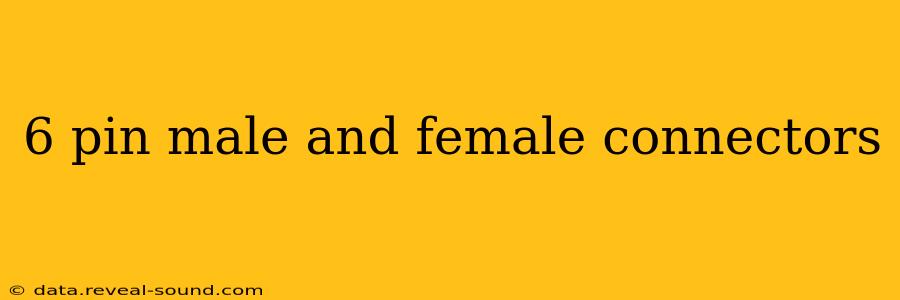6-pin connectors are ubiquitous in various applications, from electronics and automotive systems to industrial equipment and consumer gadgets. Understanding their types, applications, and specifications is crucial for anyone working with electronic components or troubleshooting related issues. This comprehensive guide dives into the world of 6-pin male and female connectors, exploring their diverse functionalities and helping you choose the right one for your needs.
What are 6-Pin Male and Female Connectors?
6-pin connectors, as the name suggests, are electrical connectors with six pins designed to mate together, transferring power and/or data signals. The male connector has protruding pins, while the female connector has corresponding receptacles to accept these pins. They come in various configurations, including:
- Straight/In-line: Pins are arranged in a straight line.
- Right-angle: Pins are arranged at a 90-degree angle, useful in space-constrained applications.
- Surface mount: Designed for mounting directly onto a printed circuit board (PCB).
- Through-hole: Designed for mounting through holes in a PCB.
The specific type of connector chosen depends on factors like the application's power requirements, the signal type (analog or digital), and the physical space available.
Different Types of 6-Pin Connectors
The market offers a wide array of 6-pin connectors, each designed for specific purposes. Key differences lie in their physical size, locking mechanisms, material composition, and electrical specifications. Some common types include:
- JST XH Series: These are popular for their small size and reliability. Often found in consumer electronics and robotics.
- Molex Crimp Connectors: Known for their robust design and ease of crimping, often used in automotive and industrial applications.
- AMP/TE Connectivity: A wide range of connectors with varying specifications and applications; many are used in higher-power applications.
- Circular Connectors: These offer a more robust and environmentally sealed connection, often used in harsh conditions.
The choice of connector will heavily depend on your application's needs and desired specifications.
What are the applications of 6-pin connectors?
The versatility of 6-pin connectors makes them ideal for a multitude of applications across diverse industries. Some common examples include:
- Consumer Electronics: Connecting peripherals, charging devices, and internal components.
- Automotive Systems: Connecting sensors, actuators, and control modules.
- Industrial Equipment: Used in automated machinery, robotics, and process control systems.
- Medical Devices: Connecting various components in medical instruments and equipment.
- Lighting Systems: Controlling and powering LED light arrays.
The specific application dictates the choice of connector type, focusing on factors such as current carrying capacity, voltage rating, and environmental resilience.
How to Choose the Right 6-Pin Connector?
Selecting the appropriate 6-pin connector hinges on several critical factors:
- Current and Voltage Requirements: Ensure the connector's specifications meet or exceed the application's power demands.
- Signal Type: Analog or digital signals necessitate different connector types and designs.
- Durability and Environmental Conditions: Harsh environments necessitate robust, sealed connectors.
- Physical Space: Connector size and orientation should be compatible with the available space.
- Ease of Assembly and Termination: Consider factors such as crimp connections, soldering, or plug-in styles.
Understanding these parameters is essential for reliable and safe operation.
What is the difference between male and female 6-pin connectors?
The fundamental difference lies in their physical structure. The male connector features six protruding pins, designed to insert into the receptacles of the female connector. The female connector, on the other hand, possesses six corresponding holes or sockets to receive the male pins. This arrangement ensures a secure and reliable connection.
How do I identify a 6-pin connector?
Identifying a 6-pin connector is straightforward: simply count the number of pins. Look closely at the connector housing to determine its type (straight, right-angle, etc.) and any markings that might specify the manufacturer or model number. This information assists in finding replacement connectors or matching compatible units.
Where can I buy 6-pin connectors?
6-pin connectors are widely available from various electronic component suppliers, both online and in physical stores. Distributor websites and online marketplaces offer a broad selection, allowing for easy comparison and selection based on specifications and pricing.
This guide offers a starting point for understanding the diverse world of 6-pin male and female connectors. Remember to always prioritize safety and consult the datasheets of your chosen connectors to ensure compatibility and appropriate usage within your application.
